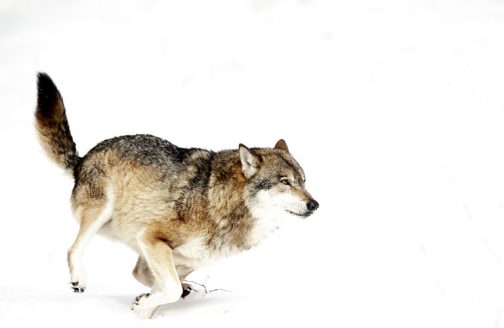The wolves are back, and Germans are debating how to reconcile the large, carnivorous predators with the rural economy

At the turn of the millennium, the wolves returned to Germany. On a military training ground in the Lausitz region east of Berlin, a wolf pair was spotted raising pups for the first time in 150 years. In other words, the 21st century began with the reemergence of wild predators. It was not generally understood as a sign of the times, but rather a curiosity, an historical misunderstanding, something to chalk up to the backwardness of the distant German east.
Today, almost 20 years later, the wolves have claimed not only a large share of Germany as their stomping ground, but a significant amount of political and media attention as well. Political parties and interest groups are quarreling over the new neighbors; the wolves are becoming the object of management schemes, ordinances, coalition agreements and Bundestag debates.
To become better oriented in the hustle and bustle of wolf-based politics, it’s helpful to see the world through a wolf’s eyes, and at least make a stab at just once assuming the standpoint of the wolves vis-a-vis the land they are reclaiming. What makes a densely populated industrial country so attractive to an animal species that purports to feel most at home in the wilderness?
The German landscape is marked by extensive agriculture, which introduces massive amounts of nutrients into the biosphere as a whole. This leads to a situation where an inordinate number of wild, hoofed mammals – deer, elk, fallow deer, wild boar – live as bountifully as never before. What for many insects, birds, amphibians and reptiles would be a death zone is nothing less than paradise for the large, carnivorous wolf.
Wild, hoofed animals – or ungulates – are their natural prey, and Germany boasts roughly 10 times as many wolf prey per square kilometer than does Siberia, while meeting many other needs of the wolf as well. Despite the frequency with which wolves fall victim to cars or trains, they find tranquility and plenty of opportunities to withdraw from peril in our forests and fields where, unlike 150 years ago, hundreds of thousands of people no longer trudge the land for work day in and day out. A sober evaluation by this wily and adaptive predator must conclude that Germany – and all of Central Europe – is an optimal habitat.
Plus, no one is really is getting in their way. The very same modernization process that led to intensive agriculture and all that it wrought is also responsible for a fundamental shift in the mindset in European societies, a shift that has given majority appeal to the idea that not only butterflies have the right to prosper, but large predators as well.
There is thus no sound claim that the wolf “does not belong in our cultural landscape,” as lupine opponents maintain. These are not strays; their return is no mistake and in no way the result of the machinations of metropolitan nature lovers imposing their whims on earnest, down-to-earth, rural populations – a myth eagerly propagated by populists, not only those in the far-right AfD party. If the wolf becomes instrumentalized as a political vehicle, it will be hard to properly address the real conflicts triggered by its return.
German and European laws provide strict protections for the wolf species. Apart from in Saxony, it is illegal to hunt wolves in Germany. But even in Saxony, the inclusion of the wolf in state hunting law does not mean that wolves can actually be hunted. It has merely added another level of bureaucracy to the issue, as now both nature preservationists and hunting authorities are involved in the fate of the wolf. Wolves may only be killed if they cause considerable economic harm or become a security risk. And a killing may only be prescribed if more benign measures have failed or are unavailable. Current law does not permit regulating, limiting or reducing the wolf population.
One possible change to this legal framework has triggered a political dispute that is driving a wedge into Berlin’s governing coalition. The Union and the agriculture ministry are pushing for controls on the population of wolves, while the SPD and environment minister are seeking to make case-by-case decisions more legally compliant and their enforcement more effective. Anything more seems impossible. Transitioning to population control would require that the European Commission change the protection status of wolves, and at the moment this is out of the question.
The most important and – to the sober eye – singularly relevant conflict linked to wolves is the fact that they feast on unprotected livestock. Not only does this have an impact on farmers, it also presents nature conservancy with conflicting goals. Extensive grassland management through grazing is essential to maintaining the biodiversity of the cultural landscape. A downturn in this form of agriculture would make for an ecological catastrophe.
Efforts by the federal and state governments are thus filtering out all the ideological bluster surrounding wolves and focusing squarely on helping keepers of livestock protect their herds by providing financial assistance and consulting as well as by compensating their damages to the greatest possible extent. In Brandenburg – the German state boasting the most wolves – certain ordinances were enacted that are serving as models for other states as well as for the federal government. It can be an arduous task to reconcile wolf and agriculture, but it pays off.
Powerful interest groups like the German Farmers’ Association and the German Hunters’ Federation are not content with this pragmatic route represented by the existing legal framework. “Upper limits” and “wolf-free zones” are the catchwords most used in their arguments. Wolves cannot be confined to zones and fewer wolves does not equate to less damage. Even if wolves could be hunted, it would do nothing to lessen the current imperative to protect herds. Moreover, the legal stipulations for the public compensation for losses caused by wolves and for herd protection would no longer apply if the wolf ceased to be a strictly protected species.
There are now some 80 wolf packs in Germany, in addition to territorial pairs and lone wolves. The number of individuals can only be estimated, but the figure is somewhere between 500 and 1,000 – most of whom cause us no harm whatsoever and escape our notice altogether.
Eckhard Fuhr
is a journalist and hunter living in Berlin and an author of several ooks about wolves and hunting. His most recent work, Jagdkunde (Hunting knowledge), published by Matthes & Seitz, came out in April 2019.




